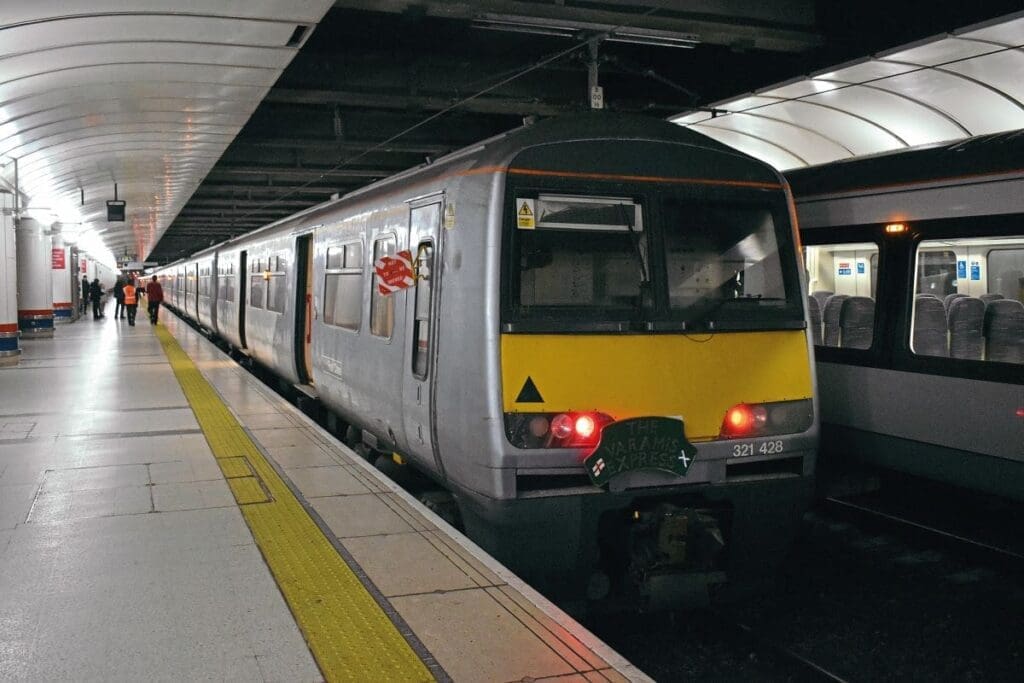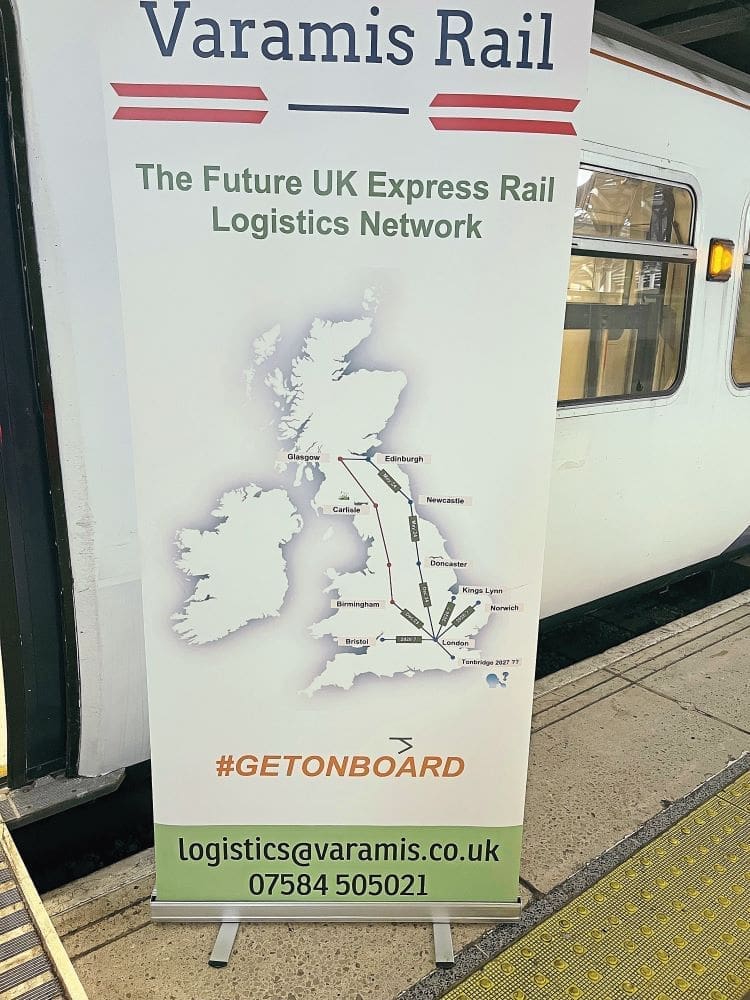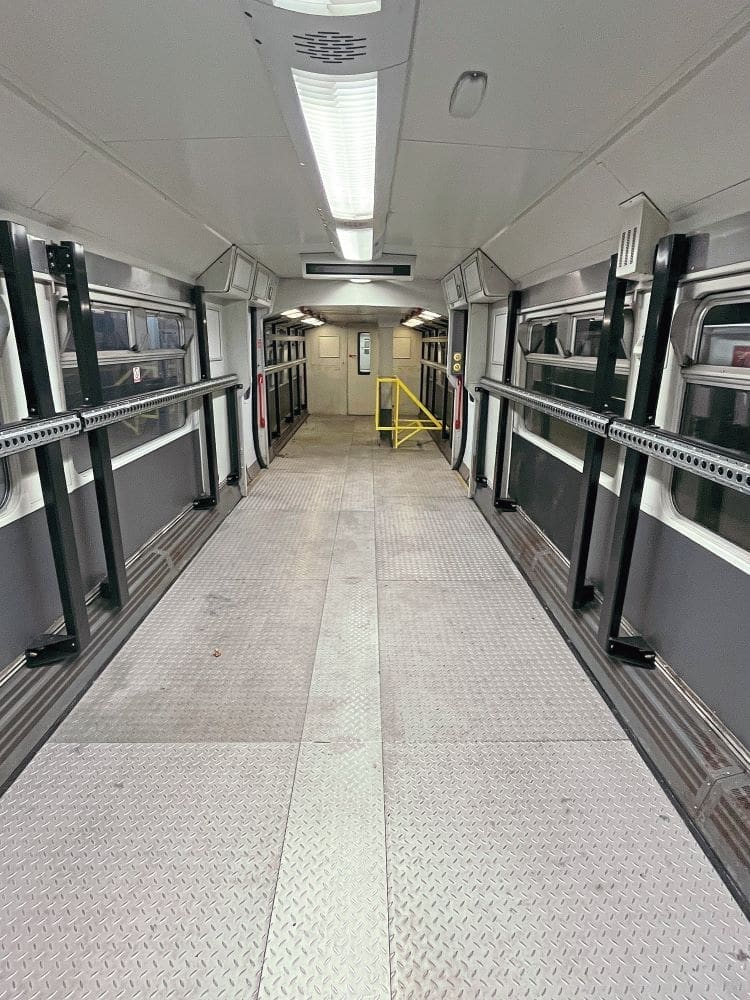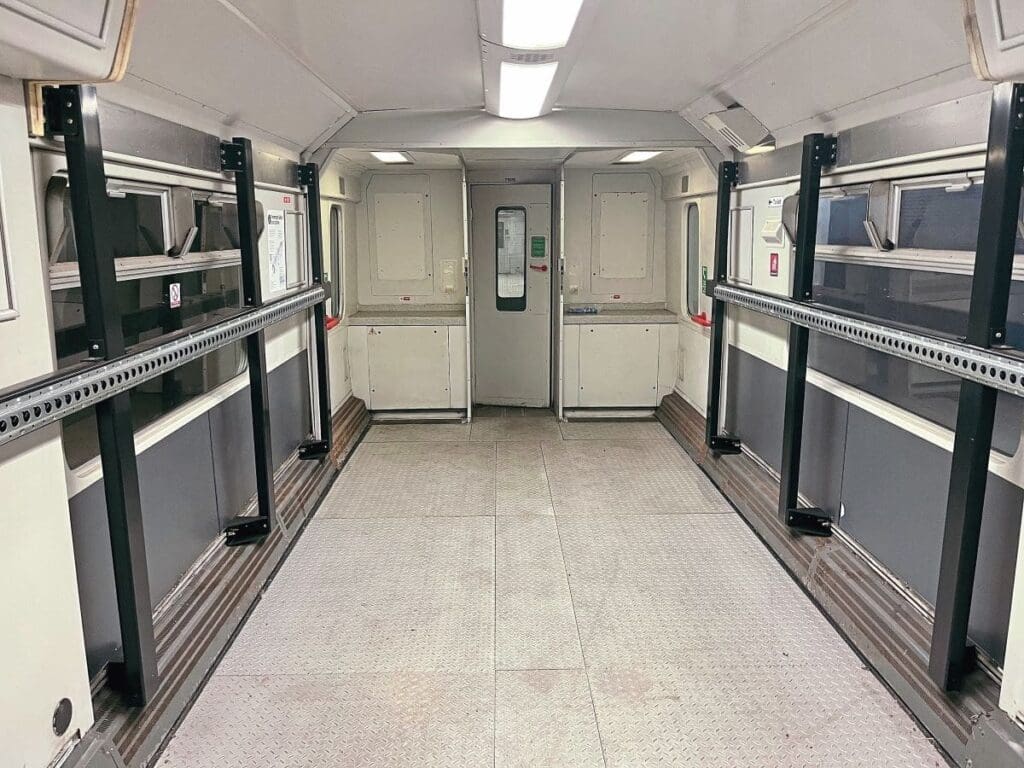Varamis Rail aims to serve London terminals with a network of electric freight services. Richard Clinnick talks to Phil Read, the man behind the plans.

Less than a year after Class 321s finished serving London Liverpool Street in daily service, a pair of the four-car electric multiple units returned to the station on March 13, to showcase their planned return, which could happen in the very near future.
Still carrying National Express East Anglia colours from their days serving the station, Nos. 321428/429 were used to showcase just what Varamis Rail is all about.
Enjoy more Rail Express Magazine reading every month.
Click here to subscribe & save.
Its business says its plans to serve Central London are quicker and more efficient, cheaper than current methods, directly reduce the carbon footprint of UK businesses, support the clean air strategies of major towns and cities and offer a sustainable alternative not achievable elsewhere.
The operator has been running trains for many months now, initially on the Birmingham International-Mossend route using No. 321334. That ‘321/3’ was the first ‘Swift’ freight electric multiple unit conversion, which its owner Eversholt Rail used as a demonstrator. Unveiled at Wabtec Rail, Doncaster, on July 1, 2021, it eventually moved to Varamis and was the sole EMU in the fleet for many months as Phil Read, the managing director of Varamis, sought to get the business up-and-running. It has since been joined by four more ‘321s’, with five more to follow.
These are all owned by Varamis now, with the business having acquired them from the rolling stock leasing company. Such has been the success of the initial service, which uses roll cages to fill the train, that the four-car train has been doubled in length and now runs as a pair of ‘321s’ with a second train planned on the same section of the West Coast Main Line.
“The transport sector in the UK remains the largest emitter of CO2. If the UK Government target of net-zero emissions by 2050 is to be met, then ambitious, carbon-free initiatives like Varamis Rail are offering are not just desirable, they are essential,” says Mr Read.

Maggie Simpson OBE, Rail Freight Group CEO, says: “Cultivating a sustainable future for urban logistics demands innovative solutions, and this underscores the pivotal role of railfreight in reshaping the transport landscape of central London. As we forge ahead, collaboration between rail and logistics industry stakeholders remains paramount in realising the vision of a greener, more efficient urban freight network with rail at the centre.”
Varamis Rail, and its partners, have worked with Transport for London on the proposals regarding serving the capital. Scott Wilding, principal strategy planner, TFL transport strategy and policy (roads and freight), says: “This signals a significant leap forward in our commitment to sustainability and improving air quality in central London. By prioritising rail freight solutions, we’re not only reducing congestion and emissions on our roads but also fostering a cleaner, healthier environment for all Londoners. Through collaborative efforts, we’re paving the way for a greener, more sustainable future where freight transportation plays a pivotal role in preserving our city’s air quality and vitality.”
More routes are also planned as Mr Read revealed at the event at Liverpool Street.
Talking to Rail Express, he said that he chose the ‘321s’ for the role as they had plenty of life in them and were capable of 100mph. Unrefurbished EMUs are a better fit for the business instead of the 30 Renatus Class 321/3s as the latter have AC traction motors which require a different safety case compared to what is available with the unmodified ‘321s’.
All the seats and tables have been removed, as the toilets have been too. They are fitted with reinforced floors to cater for the increased weight of the loads they are carrying. Bizarrely, for the time being at least, they retain their passenger information screens! The ‘321s’ remain capable of 100mph too and none have yet received a new livery, although at least two have now received Varamis Rail branding. For Mr Read, it’s about establishing the business and new routes.
“They have the same body as a Mk.3 coach and are able to go everywhere and there is no reason why they cannot serve routes that we aspire to.” One of those routes could be Tonbridge, which would not be for a couple of years yet, and Mr Read says that would be another type of unit that would be used on that, probably a Flex Class 769. The intention remains that all 10 ‘321s’ will be available for traffic by the end of the year. As this issue of Rail Express went to press, Varamis had accepted eight sets: 321334/339/341, 321407/419/428/429/440 with two from 321332/338/342 to follow. Mr Read told RE that all 10 had been acquired but had not confirmed the final sets.
He admitted that there have been issues in setting up a second route, which is planned to be Birmingham International to London, with the aim of serving Liverpool Street rather than the Princess Royal Distribution Centre (PRDC) at Willesden. Getting guaranteed paths has been a problem on the southern section of the West Coast Main Line, he said, due to ongoing engineering possessions, which is why the event at Liverpool Street, attended by Network Rail chair Lord Hendy, was so important for Varamis. “I think this is really showing people what we do and showcasing what the railway can offer in central London. It gets the buy-in from businesses and can deliver to the heart of the city.”


Mr Read has also previously highlighted his frustrations with NR in terms of paths in that he has a fleet of 100mph-capable EMUs and yet his paths offer average end-to-end timings with an average speed of around 40mph. Last mile deliveries are a possibility too with Varamis working with partners to explore what is available. “We believe that bringing electric trains into London with their high volume, then being dispersed into local areas using cargo bikes is the way forward, not just for London but any city. This could be Manchester or Birmingham, for example.”
Other locations were mentioned including Norwich and King’s Lynn. “They are all aspirations. Initially it was about Birmingham to Glasgow. We’ll extend that to London and go on the East Coast.
“What I’m trying to do, what I’ve been trying to do, is to create a circular network of high-speed, fully electric goods distribution. That’s what it’s all about,” he says. Bristol is in the plans too, meaning that Varamis Rail could become the first freight operator to use electric traction on the Great Western Main Line almost a decade after it was first electrified. “The reason I put Bristol on the map is I know the city is very forward thinking about green initiatives and developing them, and I think they’d love a fully-electric train to be serving their city.”
Using repurposed trains is one thing but Varamis is looking to the future and the possibility of a new-build fleet as the company grows. “That is something about five or six years away but it’s definitely on our radar,” he says.
“Royal Mail has an appetite for buying new trains and we’d certainly like to be a part of that. Lord Hendy has spoken about the future being this type of rail freight and multimodal business [and so] we need to look at the future. The trains could be AC-only, dual-voltage or electric with a little diesel engine and battery packs. Or battery-only?”

Varamis currently employs 25 staff including train drivers and its own operations control centre. There are also depot managers at Birmingham and Glasgow and teams in Scotland who service the goods. The trains themselves are maintained at Glasgow Shields Road by ScotRail. “They have been a great partner and we, also, get a lot of buy-in from Transport Scotland as well,” Mr Read says, adding that he believes that is partly due to SR being a nationalised operation.
While he praises TS, he admits that there needs to be more support from other government agencies. He says that the Department for Transport and Welsh Assembly Government could be more supportive and adds that he would love to hear from vocal mayors such as Andy Burnham, as well as local councils.
Network Rail Anglia route director Katie Frost said: “This shows that the future is bright for railfreight. Partners from across the industry and beyond are coming together to explore new opportunities and accelerate the shift to rail. We are proud to be playing our part in delivering greener and more efficient freight transportation, and to be hosting this showcase at Liverpool Street station, just as we celebrate its 150th birthday. Over the years, the station has been at the forefront of innovation and reinvention, so it is a fitting backdrop for this exciting event.”
Finally, Steve Evans, the founder of XeroE, which works with Varamis in London, said: “This event shows the indispensable role of companies like ours in revolutionising urban freight logistics, particularly in the critical first and last mile of deliveries in central London. By navigating congested city streets with ease and zero emissions, I’m proud that XeroE’s bikes, cargo bikes, and electric vehicles are not just delivering goods; they’re delivering on our commitment to cleaner air, reduced congestion, and enhanced urban liveability. Our partnership with Varamis Rail enables us to make initial bulk deliveries into the centre of cities sustainable. But not only that, it costs less. This means we can provide clean green deliveries at competitive prices and reduce the barriers to businesses that want to make the switch.”
These are exciting times for Varamis Rail, and it will be interesting to watch the company attempt to serve new locations and continue to grow its business.
Varamis Rail Fleet
| Unit | Livery |
| 321334 | SW |
| 321339 | NU |
| 321341 | NU |
| 321407 | FB |
| 321419 | FB |
| 321428 | NX |
| 321429 | NX |
| 321440 | NU |
Livery code: FB – FirstGroup blue, NX – National Express, NU – National Express unbranded, SW – Swift




